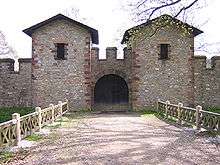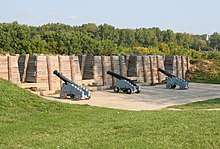Fortifications
Fortified locations, military constructions, or buildings, have been built from antiquity all the way to the present. At many archaeological sites and in some old towns they are the dominant structures.
Understand
There are iron age hill forts, Roman forts, Western forts and military structures through history to the present day. Medieval castles are a specific class of fortifications dominant before the arrival of gunpowder and cannons.
A stockade is a wooden fortification used around the world; especially in colonial settlements such as the American West.
A city wall was common for ancient and medieval cities; not just for defense, but also for tax collection. In modern times, many walls have been scavenged for stone, or torn down for railroads. Very few intact city walls remain.
The bastion fort, also known as star fort, was prevalent in Europe and European colonies from the 15th to 19th centuries, as a platform for cannons, and defense against enemy cannons and firearms. Some were large enough to incorporate a whole town.
In the 19th century, cities became larger and cannons became stronger, and bastion forts were replaced by polygonal forts. Since the end of World War II, fortifications have become less useful. Many of the military installations which have been in used since then, are underground works and different kinds of bunkers, serving as command centres and bomb shelters.
Many fortifications have been used as prisons; see history of justice.
Europe
While the Roman Empire had many river borders (not because rivers were uncrossable, but because patrolling them by boat was easier than patrolling land borders), in places where no river was available, they built walls and fortresses, some of which remained distinctly visible for centuries, with the Germanic Limes and Hadrian's Wall in Northern England perhaps the most notable. However, it was the Middle Ages with its countless mid sized and tiny polities and warfare with heavy focus on relatively small heavy cavalry units and siege warfare that gave rise to many European fortifications still in existence to this day.
France
In part due to a distinct manpower disadvantage caused by lower French birth rates, France built fortifications for both World War II in Europe and World War I. Germany tried to go around the bulk of those in both wars by violating the neutrality of Belgium. While the French plan was partially successful in World War I, the "Maginot Line" as it was called was not able to stop or even delay the rapid advance of German tanks in World War II. While some argue that the purpose always was to force the German army to once more violate Belgian neutrality and invade through the Ardennes (a heavily wooded, hilly terrain, then deemed unsuitable for major offense) the fact of the matter is that France capitulated in a matter of weeks in 1940.
Germany

The English term castle has two words with different nuances of meaning in German. A Burg (from which the word "burgher" is derived, a person who can expect protection in a Burg) is mainly a military defensive structure and any purpose as a residence is secondary to the military purpose whereas a Schloss is largely a representative building with little or no military value. However, many a Schloss is made to look like a Burg and even originally military buildings may have taken on non-military purposes later on. Festung is a generic German word for a fortress.
- 🌍 Bundesfestung Ulm (Ulm). The "Federal Fortress" of the German Confederation (1815-1866) was one of very few installations the loose German Confederation had in common rather than as the property of individual member states. It never saw a shot fired in anger and was primarily intended for a defensive war the German Confederation never fought so it is in unusually good condition today.
- 🌍 Festung Ehrenbreitstein, Koblenz. This is a big military castle/fort in good condition. From there you have a good view over Koblenz. There is also one of the museum of Koblenz. It is located on the other side of the Rhine. entry fee about €2.
- 🌍 Roman Fort Saalburg, Bad Homburg (Take a bus from Bad Homburg, or take the "Taunusbahn" to station "Saalburg" and walk 45 minutes along the Limes to reach the fort.). near World Heritage Site Limes (border wall between the Roman Empire and free Germanic lands)
Switzerland
While the Swiss last went to war in 1848 in a civil war mostly between Catholic conservatives and Reformed liberals and Switzerland was last invaded by a foreign power in the Napoleonic Wars, the Swiss had an elaborate and costly defense scheme in place for World War II in case Germany (or any other power) ever violated Swiss neutrality. This "national redoubt" was for a time credited with making invasion seem so costly as to make Germany reconsider; however, these days many historians point out that the Nazis had little to gain from invading Switzerland and neutral Swiss banks were an important factor for the German wartime economy.
United Kingdom
- 🌍 Whitehorse Hill, Uffington (near Wantage). The site of an Iron Age hill fort and Uffington White Horse. The site sits on the ridgeway long distance footpath, which follows the line of a chalk ridge which separates the Berkshire Downs to the south and the vale of the white horse to the north. The horse has been cut into the chalk downs can be seen from miles around. It has been "cleaned" by local communities about every 20 years continuously since it was first made about 2000 to 3000 years ago. The hill fort consists of a large circular bank and ditch 1-1.6km in circumference, with grass all over and inside. There are great views from the site, which is fantastic for pic-nics on a sunny day. Also nearby is the Dragon's Hill which appears to be man made and could somehow be associated to the site. Access is easiest by car - it has two car parks (one of which is nearer the horse and recommended only for visitors requiring easier access) The lower car park includes some signage explaining the Whitehorse, and ridgeway. There are picnic tables near by. One could also easily take in the White Horse and Hill Fort, on a walk along the ridgeway.
Middle East
The Middle East is the cradle of organized warfare with standing armies distinct from the general population and thus also saw some of the earliest sieges we know of. However, many of them are archeological sites or buried between several layers of newer construction. The Trojan War took place in what is now Anatolia and is said to have involved a ten year siege with projection of power across the Aegean Sea over three millennia ago. During the Crusades, "Crusader States" arose in the Levant, establishing a tiny (largely immigrated) Catholic elite in largely Muslim, Jewish or non-Catholic Christian regions and as such the rulers built impressive (and in some cases still extant) fortresses to defend their hard won territories against the inevitable Muslim counterattack.
- 🌍 Masada. The fortress was used in the "Big Jewish War", the first and largest of three uprisings by Jews in the then Roman province IUDAEA against the Roman Empire. Here the original Zealots (from whom the English word derives) held out after Jerusalem (and the Temple with it) had already fallen, but ultimately the Romans built a giant ramp to conquer the fortress. The sources tell us that the defenders entered into a suicide pact killing virtually everybody inside so as to not fall into Roman hands alive. Archeological evidence has largely lent credence to this story. Masada has often been cited as an important Zionist symbol and Israeli soldiers have in the past been sworn in here and the sentence "Masada mustn't fall a second time" is a Zionist saying indicating that the catastrophe of losing the Jewish homeland mustn't repeat under any circumstances. These days there is a gondola lift to the top, but it doesn't operate before sunrise and sunrises at Masada are said to be particularly stunning.
Turkey
Due to its position along the major routes of the Old World, trampled as many invaders as traders, Turkey is very rich in fortifications, ancient and modern alike. For a start, banks of the Turkish straits are lined with impressive fortresses, often with commanding views of their surroundings—see the Istanbul and Çanakkale articles for full details. Many towns along the Aegean and Black Sea coasts feature fortresses that started life as trading posts of the Genoese, who controlled trade in the medieval Mediterranean. The lush hillsides and valleys of Eastern Karadeniz, in the far northeast, are dotted by castles that are often likened to those found in fairy tales, while Çukurova (Cilician Plains) in the south of the country is home to a relatively large number of Crusader-era fortresses. The isolated Mediterranean coast to the west is the site of a couple castles that are often considered the most scenic in the country. Further west, Bodrum, Antalya, and Alanya have some of Turkey's most famous and well-visited castles.
North America
Canada
- 🌍 Fort Calgary, 750 9 Ave SE, Calgary, ☎ +1 403-290-1875. 9AM-5PM daily. Fort Calgary, a Northwest Mounted Police (NWMP, now RCMP) fort was built in 1875 at the confluence of the Bow and Elbow rivers (near modern Inglewood). It became the nucleus around which Calgary grew. The original fort was destroyed decades ago. Today's Fort Calgary is a museum and historic site focusing on the history of the city and of the RCMP. $12/7 (adult/youth).
- 🌍 Citadelle of Quebec (Citadelle de Québec). One of the oldest citadels still in active use.
United States of America

- 🌍 Fort Meigs, Perrysburg (Ohio). Largest wooden walled fort in North America. Used in the war of 1812.
- 🌍 The Alamo. An iconic mission and fort, where Davy Crockett, James Bowie, and a number of Texans made their last stand.
- 🌍 Fort Elizabeth. A strange Russian fort that was built in Hawaii during the 1800's.
South America
Peru
- 🌍 Sacsayhuamán. A large Inca fortress, mostly made of stonework.
Asia
China
The Great Wall of China is a series of walls, expanded throughout the long history of Imperial China.
Philippines
- 🌍 Fort Santiago. A citadel built by Spanish conquistadors, it played an important role in many moments of Philippines history up to World War II.
Malaysia
- 🌍 A Famosa. A Portuguese fort that was built in Malacca Malaysia in the 1500's. What little remaining is some of the oldest European architecture in Asia.
Oceania
Australia
- 🌍 Fort Queenscliff. A historic fort built in the 1860's and used in various capacities to the present day. Due to its strategic location and telegraph connection, this fort fired some of the first Allied shots in both World Wars.
New Zealand
- 🌍 One Tree Hill. One of the largest Māori pā forts, and one of the larger earthworks in general.
See also
- Castles - Medieval
- Grand and Great houses - chateux, stately home, manor house, Schloß, Resedenz, palace
- Military tourism
